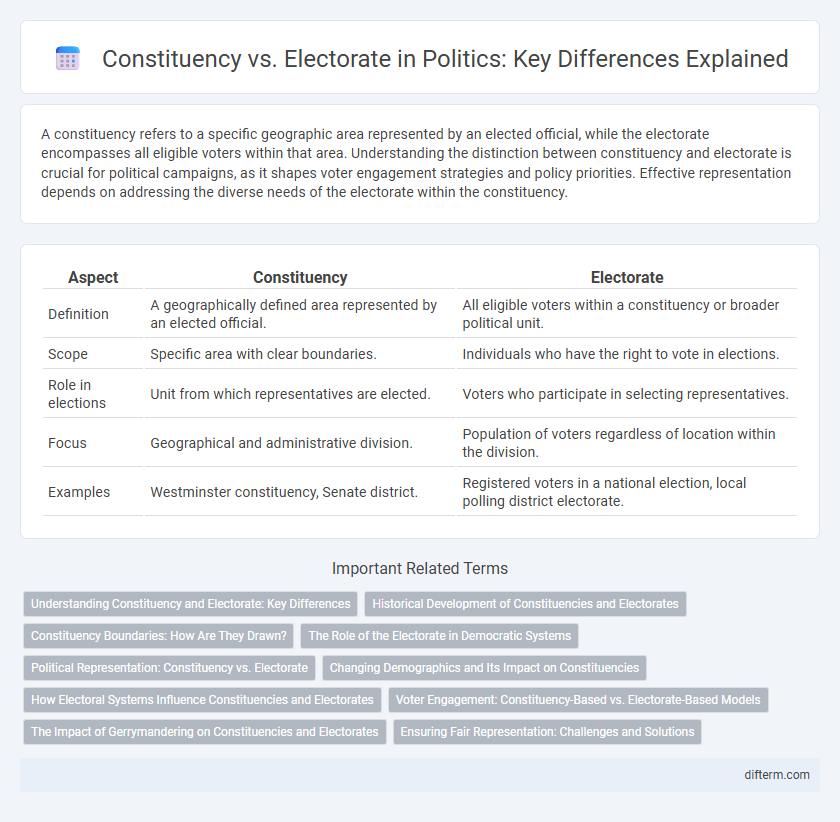A constituency refers to a specific geographic area represented by an elected official, while the electorate encompasses all eligible voters within that area. Understanding the distinction between constituency and electorate is crucial for political campaigns, as it shapes voter engagement strategies and policy priorities. Effective representation depends on addressing the diverse needs of the electorate within the constituency.
Table of Comparison
| Aspect | Constituency | Electorate |
|---|---|---|
| Definition | A geographically defined area represented by an elected official. | All eligible voters within a constituency or broader political unit. |
| Scope | Specific area with clear boundaries. | Individuals who have the right to vote in elections. |
| Role in elections | Unit from which representatives are elected. | Voters who participate in selecting representatives. |
| Focus | Geographical and administrative division. | Population of voters regardless of location within the division. |
| Examples | Westminster constituency, Senate district. | Registered voters in a national election, local polling district electorate. |
Understanding Constituency and Electorate: Key Differences
Constituency refers to the specific geographic area represented by an elected official, whereas electorate comprises all eligible voters within that area or country. The constituency often influences political priorities through localized interests, while the electorate reflects the broader voter base impacting election outcomes. Understanding the distinction is crucial for analyzing political representation and voter behavior in democratic systems.
Historical Development of Constituencies and Electorates
Constituencies historically evolved as defined geographic areas represented by elected officials in parliamentary systems, often shaped by population growth and political reforms such as the Reform Acts in the 19th century United Kingdom. Electorates expanded alongside these changes, reflecting broader enfranchisement movements that extended voting rights beyond property-owning men to include wider demographics such as women and minorities. This historical development illustrates the gradual shift from limited, elite-controlled representation toward more inclusive democratic participation within modern political systems.
Constituency Boundaries: How Are They Drawn?
Constituency boundaries are delineated by independent boundary commissions, which use population data, geographic features, and community interests to ensure fair and effective representation. The commissions conduct public consultations before finalizing maps to balance equal voter distribution and maintain coherent local identities. Periodic reviews account for demographic changes, preventing malapportionment and ensuring constituencies reflect current population patterns.
The Role of the Electorate in Democratic Systems
The electorate, comprising eligible voters within a democratic system, holds the power to influence political outcomes through participation in elections, directly shaping government representation. Unlike the constituency, which refers to the geographic area represented by an elected official, the electorate embodies the collective decision-making body that legitimizes political authority and policy mandates. Engaged electorates enhance democratic accountability by evaluating candidates and policies, ensuring that representatives remain responsive to the public's needs and preferences.
Political Representation: Constituency vs. Electorate
Political representation hinges on the relationship between constituencies and electorates, where a constituency denotes a geographically defined area represented by an elected official. The electorate comprises all eligible voters within that constituency who influence political accountability through voting behavior. Understanding this dynamic is essential for analyzing how representatives balance local interests with broader policy mandates.
Changing Demographics and Its Impact on Constituencies
Changing demographics reshape constituencies by altering population size, age distribution, and ethnic composition, which influences voting patterns and political priorities. Electoral boundaries often need adjustment to ensure fair representation as urbanization and migration shift electorate concentrations. Political parties must adapt strategies to address evolving constituent needs and diverse socio-economic backgrounds within dynamic electorates.
How Electoral Systems Influence Constituencies and Electorates
Electoral systems shape constituencies by determining their size, boundaries, and the degree of representation, with proportional representation creating larger, multi-member constituencies and majoritarian systems favoring smaller, single-member districts. The nature of the electoral system influences the behavior and composition of the electorate, as proportional systems encourage broader voter engagement and coalition-building, while majoritarian systems often lead to a focus on swing voters and majority interests. These structural differences impact political accountability, party strategies, and voter turnout within various democracies.
Voter Engagement: Constituency-Based vs. Electorate-Based Models
Constituency-based models promote localized voter engagement by focusing on specific geographic areas, fostering direct accountability between representatives and their constituents. Electorate-based models emphasize broader, often issue-driven participation that transcends geographic boundaries, appealing to shared interests across the entire voting population. Effective voter engagement strategies leverage insights from both models to enhance political representation and democratic responsiveness.
The Impact of Gerrymandering on Constituencies and Electorates
Gerrymandering manipulates constituency boundaries to disproportionately favor specific political parties, undermining the principle of equal representation in electorates. This practice dilutes the voting power of certain demographic groups, leading to skewed election outcomes that do not accurately reflect the electorate's preferences. Consequently, gerrymandering erodes public trust in the democratic process by creating uncompetitive constituencies and entrenching political incumbents.
Ensuring Fair Representation: Challenges and Solutions
Constituency boundaries often face challenges such as gerrymandering, which undermines fair representation by distorting electoral outcomes and diluting voter influence. Ensuring fair representation requires independent boundary commissions that use transparent criteria, including population equality and community interests, to draw districts objectively. Implementing proportional representation systems can also address disparities by aligning elected officials more closely with the electorate's diverse preferences.
constituency vs electorate Infographic

 difterm.com
difterm.com